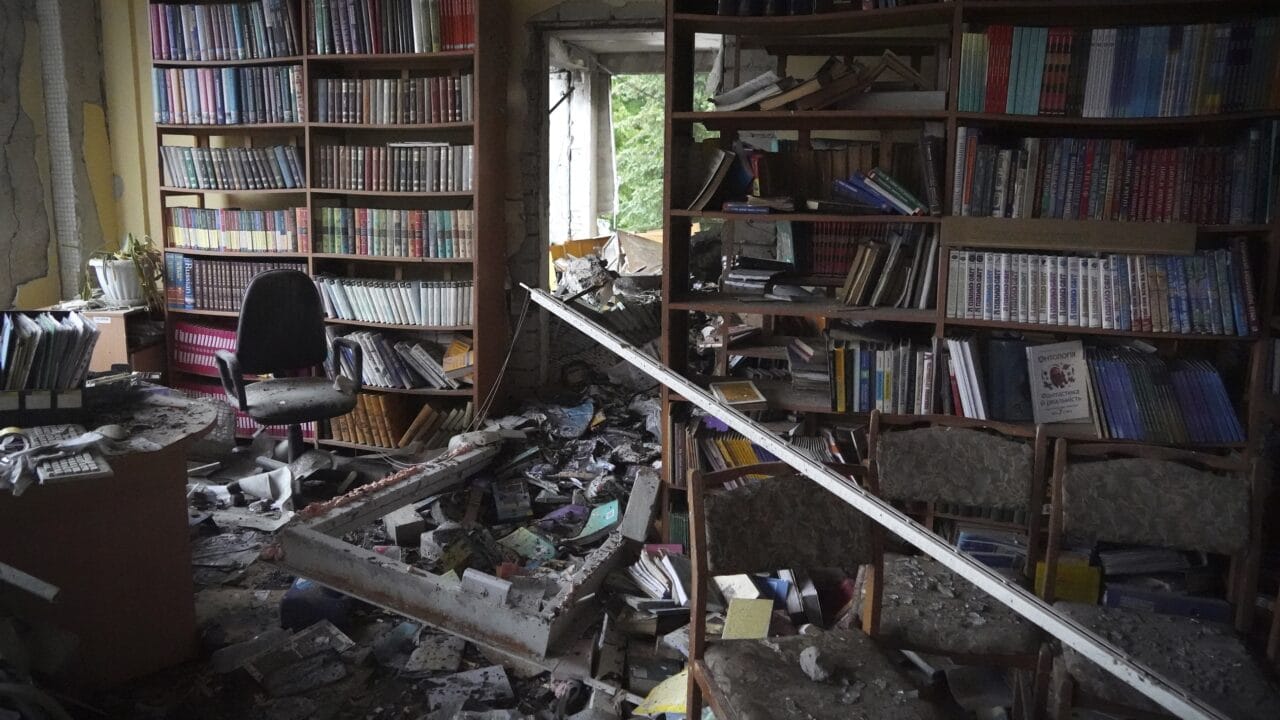CAIN BURDEAU
One hundred days ago, Russian President Vladimir Putin launched a full-scale invasion of Ukraine. Now much of the vast country in Eastern Europe lies in ruins, thousands of civilians and soldiers have been killed and the world’s superpowers are engaged in a perilous global struggle.
(CN) — Friday marked the 100th day since Russian President Vladimir Putin ordered a massive invasion of Ukraine in February and upended world politics by launching a major war in Europe and turning his country definitively away from the West.
Intense and bloody fighting continued to rage along 620 miles of front lines in eastern and southern Ukraine on Friday with Russian and pro-Russian Ukrainian rebels close to seizing the eastern city of Sievierodonetsk and shelling the neighboring city of Lysychansk.
After 100 days of horrific fighting, much of Ukraine lies in ruins and the country, the second largest in Europe after Russia, faces even more destruction and death because there is little hope for a ceasefire any time soon as peace negotiations have stalled or ceased altogether. The last serious attempt at a ceasefire took place in Istanbul at the end of March before quickly falling apart.
Russian forces now occupy about 20% of Ukraine, an area slightly larger than Croatia or a little smaller than West Virginia, and new pro-Russian administrations are being established in eastern and southern territories taken away from Kyiv. In cities like Kherson and Mariupol, residents now line up for Russian passports, use the ruble as currency, get Russian channels on their televisions and are switching to Russian curriculum in schools.
Before the invasion, Ukraine had lost control of about 7% of its territory following Russia’s annexation of Crimea in 2014 and the occupation of parts of the Luhansk and Donetsk regions by pro-Russian separatists who declared themselves breakaway republics.
The war’s death toll stands in the thousands, though the number of civilians and soldiers killed remains murky.
The United Nations’ human rights agency has recorded 4,183 civilian deaths, but the real toll is much higher. According to news reports, Ukrainian officials say as many as 50,000 people may have died in Mariupol, a southeastern port city that was the scene of horrific battles and bombings. The city fell to Russian forces last month when thousands of Ukrainian soldiers holed up inside the bunkers of the Azovstal steelworks surrendered.
Russian troop deaths have been estimated between 15,000 and about 31,000 by Western and Ukrainian officials, but Russia’s defense ministry has not provided a figure.
Ukraine, too, has not said how many of its soldiers have been killed, but recently Ukrainian President Volodymyr Zelenskyy said between 60 and 100 soldiers are being killed each day in the battles in Donbas, the name for the eastern regions of Ukraine. Ukraine’s losses may be as bad and perhaps even worse than those suffered by Russia, which has the upper hand in firepower and troop levels.
According to U.N. data, more than 6 million Ukrainians fled the country, though about 2.2 million have returned following Russia’s retreat from areas surrounding Kyiv. In addition, about 7.1 million Ukrainians have become “internally displaced,” a term given to people who remain in their home country but who have been forced to flee their homes. Before the war, Ukraine had a population of about 43.5 million people.
Incessant shelling and fighting has caused immense damage to roads, hospitals, bridges, hospitals, municipal water systems, electrical grids, dams, housing stock and so much else.

In April, Ukraine said about 30% of its infrastructure was destroyed or seriously damaged at a cost of more than $100 billion. This week, Ukrainian officials estimated about 14,900 miles of roads and 300 bridges have been destroyed.
Ukraine’s parliamentary commission on human rights says Russia’s military has destroyed almost 38,000 residential buildings. Nearly 1,900 educational facilities from kindergartens to grade schools to universities have been damaged, including 180 completely ruined. About 500 factories and about 500 hospitals have been damaged, according to Ukrainian officials.
In reality, this war started eight years ago in 2014 following the overthrow of Ukrainian President Viktor Yanukovych in a violent mass uprising called the “Maidan Revolution” or the “Revolution of Dignity.”
Yanukovych, who was accused of corruption, was democratically elected but he caused great anger in parts of Ukraine, especially western Ukraine, by rejecting a deal to put Ukraine on the path of becoming part of the European Union. When he deepened Ukraine’s alignment with Russia, protests broke out and turned violent.
After Yanukovych fled the country and a pro-Western government was installed in Kyiv, protests broke out in eastern and southern parts of Ukraine, home to many ethnic Russians.
The crisis worsened dramatically after Russia’s military illegally annexed Crimea, a peninsula with deep ties to Russia and the base for its Black Sea Fleet. Fighting then broke out between Ukraine’s army and pro-Russian insurgents who declared two eastern regions independent.
Over eight years of fighting in Donbas, about 14,000 people were killed and up to 2 million people were forced out of their homes. Ceasefire deals, overseen by France and Germany, cooled the fighting in eastern Ukraine, but failed to end the conflict and tensions over Ukraine escalated following the election of Joe Biden to the White House.
The war in Ukraine can also be seen as a titanic struggle for global supremacy between superpowers with China tacitly aligning itself with Russia while the United States, the European Union and others, such as Japan and Australia, are standing with Ukraine.
In launching the invasion, leaders in Moscow said they could not allow the United States and NATO to encroach on the borders of Russia by turning Ukraine into a NATO ally. More broadly, Russia’s political leaders talk about upending a world order dominated by the U.S. and say they want to expand their influence in the developing world.
Biden and Western allies say Russia under Putin has become the world’s No. 1 pariah and that it must be defeated in Ukraine to protect democracy from autocracy. Upon taking office, Biden talked about the need to face the threat to democracy posed by Putin and other authoritarian leaders.
Increasingly, Western elites and experts talk about not only wanting to defeat Russia’s military in Ukraine by arming Kyiv with advanced weapons and providing billions of dollars in support but to weaken and even neuter Russia’s global ambitions through a massive economic embargo.
Russia has been hit with more than 5,000 sanctions, more than any other country, according to Evgeny Gontmakher, the academic director of European Dialogue.
Some $300 billion of Russian gold and foreign exchange reserves in the West have been frozen, he added. Most Western businesses have left Russia, the MOEX Russia stock index is down nearly 40% from the start of the year and inflation in Russia is soaring.
But the West too is being hit hard by the economic fallout with inflation rising as the price for fossil fuels and commodities continues to climb.
Courthouse News reporter Cain Burdeau is based in the European Union.




Kimberly Ann Goguen told Kerry Cassidy on her Project Camelot interview at the end of May both Ukraine and Russia will be broke in two months and unable to finance further war.
To understand this calamity, the focus shouldn’t be on who suffers, it should be on who profits. The same tribe benefits. By the way, did Russia ever vote to condemn Israel on the Security Council? We know Zelensky’s a globalist puppet for shapeshifters Schwab, Soros (Schwartz) & Nuland (Nudelman). But what about Putin? His mother Maria Ivanovna Shelomova was listed as Jewish in his passport application. Zionists need Putin & Zelensky for WW3 & the Great Reset. And without those 2 crisis actors there’s neither. Don’t forget that the blood drinkers always, always control both sides.
It’s not hard to detect a pro-Ukrainian slant to this article.
For one, Russia’s “incursion” could be described as a “self-defensive” action (given the 30 illegal Ukrainian bioweapons labs on its doorstep and the $150 billion in weapons-grade uranium in Zaporhizhia) or a “retaliatory” action (given the 1600 missiles lobbed per day against the pro-Russian Donetsk and Lukantsk republics prior to the war) or even a “preventive” action (given the large buildup of Ukrainian forces in the Donbass immediately prior the conflict).
Russia has taken great steps to avoid attacking the two great historic cities of Kiev and Kharkiv, only deliberately attacking munitions. Most of the other cities taken over by Russia have not been seriously damaged, and the entire western half of Ukraine has remained unscathed except for the destruction of strategic miiitary targets. Mariupol was greatly damaged (although many areas of the city were largely untouched) but that’s because the vicious neo-Nazi Azov battalions were holed out in hospitals, schools, museums, industrial plants, and the like. Already Russian-conquered areas are springing back to life.
Russia is taking its time because it has to restore law-and-order and governmental administration in the areas it has taken over. It may take months but everything from Transnitria east to the Dneiper and north to Kharkiv (basically the eastern, pro-Russian half of former Ukraine) will be part of a NovoRussiya. Russian Armed Forces are suffering casualties at a small fraction of the Ukrainian Army. By independent (nonWestern estimates), Russia may have lost 3000 soldiers, but the number of Ukrainian dead, wounded and surrendered is approaching if not already beyond 100,000.
One may argue about the numbers but one cannot argue about two things: 1) the long tank column waiting outside of Kiev for several weeks never was struck, which proves Kiev had lost its air or long-range artillery capabilities early on in the war; and 2) large numbers of surrendering Ukrainian soldiers are beyond normal military age, suggesting Ukraine is digging deeply into its reserves.
The time-course of the Russian conquest may be in doubt, but the final outcome is not.
Little doubt Cain is a spokesman for the West. His articles seem fairly objective, but as you have said, look a little closer and you can easily see the bias. Of course, not a mention of The US involvement in 2014 or the NATO creep in defiance of any agreement. Russia will prevail and Zelensky will return to playing the piano. They need something to keep eyes away from the great reset.
I don’t think 1600 missiles per day could be launched into the Donbas region for seven years. Russia’s annexation of Crimea was completely legitimate as it was done by plebiscite and those living in the the area voted overwhelmingly to join Russia. It has been a major error in US diplomacy for the US not to recognize Russia presence in Crimea as legitimate. There was never any Russian invasion into Crimea in the first place. Russia’s relationship with Crimea dates back to somewhere around 1773, the time of Mozart. It’s most similar to the US Navy operating a large navel base in Peal Harbor. However it should be noted that the US military did overthrow the Hawaiian monarchy around the turn of the previous century. Presently I believe the US military is the largest land owner in the Hawaiian Islands. I’m more concerned about honest elections in the US than I am about Russia’s self-defense operations in Ukraine.